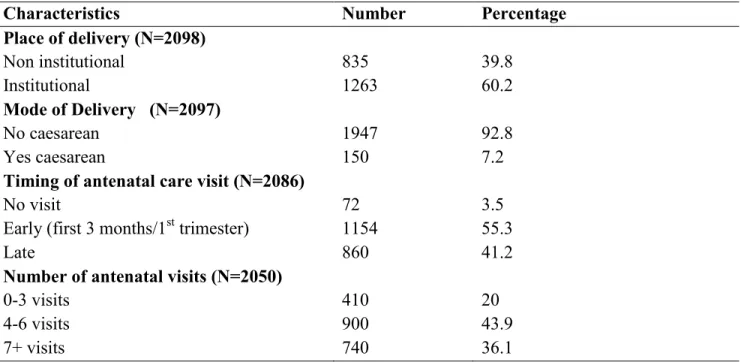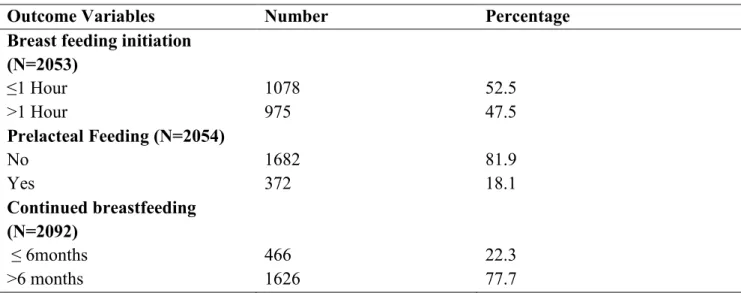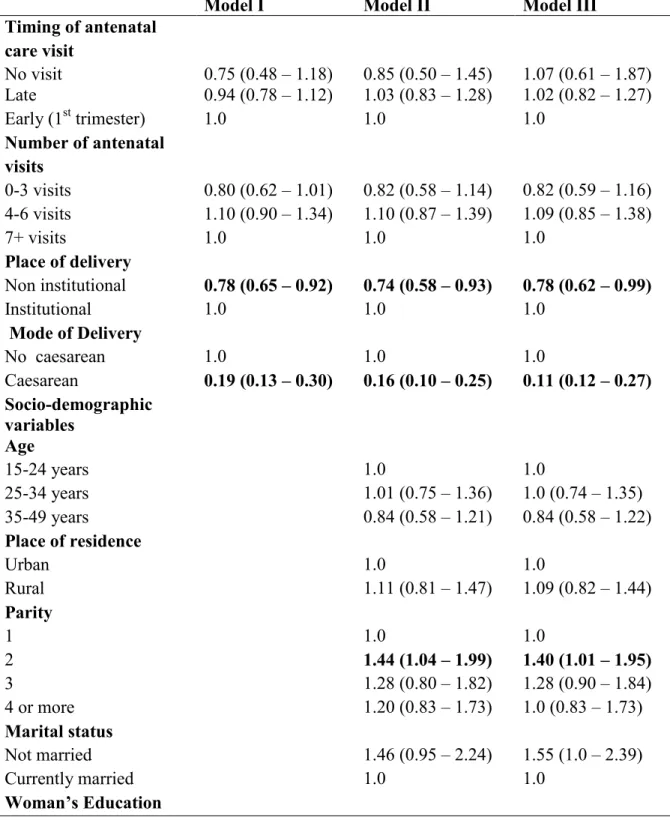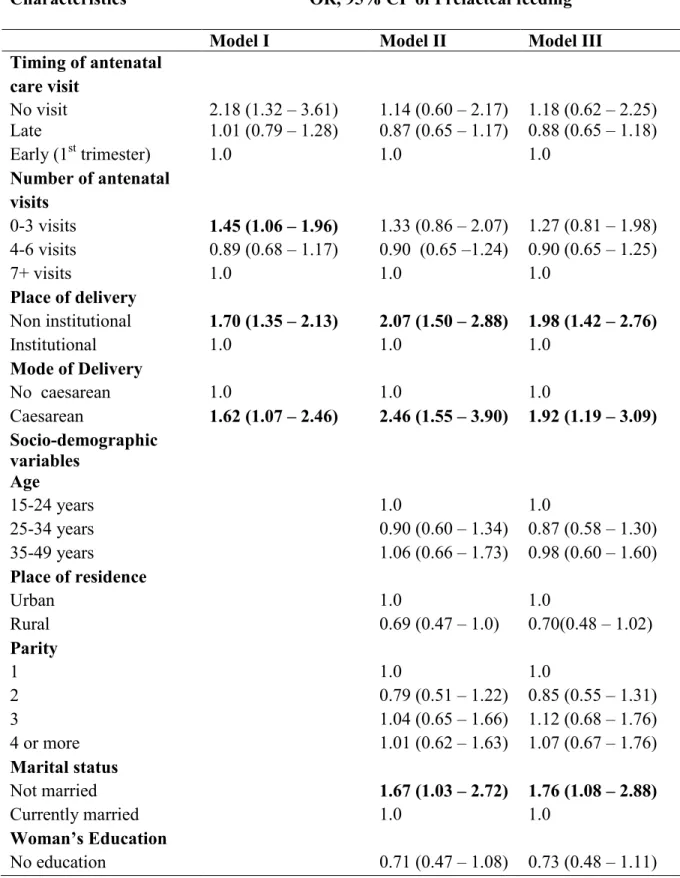The aim of this study is to determine the association between components of maternal health care use and infant feeding practices, such as: initiation of breastfeeding, pre-lacteal feeding, and continued breastfeeding. Initiation of breastfeeding, prelacteal feeding, and continued breastfeeding beyond six months were the infant feeding practices evaluated in this study. Conclusion: This study showed that infant feeding behavior was partially determined by maternal health care use during pregnancy.
Therefore, the components of maternal health care utilization need to be addressed in scaling up infant feeding in Ghana.
INTRODUCTION
Maternal health care use and the adoption of essential nutrition actions are essential reproductive health care interventions aimed at reducing neonatal and infant mortality, especially in the first week of life and even up to 1,000 days after birth (WHO, 2012; Save the Children, 2012). In addition, the important role of maternal healthcare utilization in infant feeding has been shown in numerous epidemiological surveys (Mehnaz et al, 2010; Nwaru et al, 2011; Mattar et al, 2007). A number of studies have shown that this specific component of maternal health care utilization promotes the adoption of other components such as institutional delivery (Feyissa and Genemo, 2014; Abeje et al, 2014; Sugathan et al, 2001).
This study complements previous research in identifying target groups in need of attention, provides recommendations to encourage behavioral change, and establishes strengths and inadequacies of the maternal health care utilization package.
LITERATURE REVIEW
- Components of maternal health care services
- Components of antenatal care (ANC)
- Determinants of Antenatal care utilization
- Antenatal care utilization and infant feeding practices
- Antenatal education and counseling
- Components of institutional delivery
- Determinants of institutional delivery
- Institutional delivery and infant feeding practices
- Components of breastfeeding initiation
- Determinants of early breastfeeding initiation
- Benefits of early breastfeeding initiation
- Prelacteal feeding and exclusive breastfeeding
- Determinants of prelacteal feeding
- Continued breastfeeding and complementary feeding
- Determinants and benefits of continued breastfeeding
- Cesarean delivery and breastfeeding practices
- Conclusion of literature review
This awareness has led to the assessment of several components of maternal health care use, especially prenatal care, on life-saving interventions. A study from Nepal found that age, education, parity, wealth and place of residence were significantly associated with prenatal care (Neupane and Doku, 2012). Considering the benefits of using prenatal care for babies' health, growth, and nutrition, a number of studies report positive results.
Additionally, in a study from Nepal, Neupane and Nwaru demonstrated that more than three antenatal visits were associated with a higher likelihood of breastfeeding within one hour of delivery. Adequacy of antenatal care does not always predict breastfeeding, suggesting a strong influence of extraneous factors (Swigonski et al, 1995). In rural India, the role of antenatal care as one of the strongest predictors of institutional births has been further highlighted.

STUDY AIMS
Overall Aim of the study
Specific Objectives of the study
Research hypothesis
MATERIALS AND METHODS
- Data source
- Study design and study subjects
- Procedures of data collection
- Measurement of variables
- Outcome variables
- Socio-demographic variables
- Statistical analysis
Three questionnaires were used in the 2008 GDHS: the family questionnaire, the women's questionnaire and the men's questionnaire. The women's questionnaire was used to collect information from women about themselves and their children born in the five years before the study (2003). The men's questionnaire provided similar information to the women's questionnaire, except for reproductive history and questions related to maternal health and nutrition.
In this study, this variable was categorized as "Early" when it occurred during the first trimester (0-3 months) and. This was assessed from the question "How many times did you receive antenatal care during this pregnancy" for the purpose of this study this variable was categorized into 0-3, 4-6 and 7 plus visits. The question "was (NAME) born by caesarean section?" was used to determine the mode of delivery and it was categorized into "Yes" and "No caesarean section".
Mothers were asked "How long after birth did you breastfeed (NAME)?" In this study, the variable was categorized into “≤ 1 hour” and “> 1 hour” after birth. The rationale for categorizing this variable is according to WHO recommendations which state that mothers should start breastfeeding within one hour after birth (WHO, 2013; Debes et al, 2013). A review of a number of studies that examined factors influencing the use of maternal health care informed the selection of the above socio-demographic variables as covariates in this study.
The sample was then divided into quintiles from the lowest (poorest) to the highest (richest). The use of weighting in this study was performed in SPSS (Statistical Package for the Social Sciences) using the weight command with the weight variable.
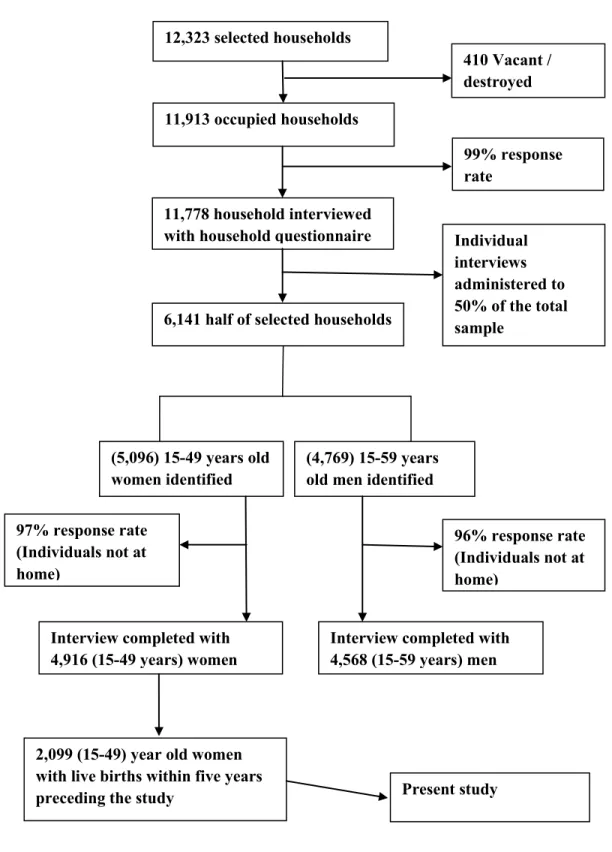
RESULTS
- Socio-demographic characteristics of study participants
- Antenatal care utilization
- Place and mode of delivery
- Infant feeding practices
- Breastfeeding initiation
- Prelacteal feeding
- Continued breastfeeding
- Maternal health care utilization and infant feeding practices
- Maternal health care utilization and breastfeeding initiation
- Maternal health care utilization and prelacteal feeding
- Maternal health care utilization and continued breast feeding
In addition, the following showed similar significant associations with prelacteal nutrition: place of birth (P<0.001), time of first antenatal visit (P<0.003) and number of antenatal visits (P<0.035). Women practicing prelacteal nutrition were mostly those who started prenatal care visits early (55%) and who had 4-6 ANC visits (40%). Compared with a normal vaginal delivery, a caesarean section was significantly associated with lower odds of initiating breastfeeding within one hour of delivery (OR 0.19, 95% CI.
Association of maternal healthcare utilization with breastfeeding initiation was adjusted for socio-demographic variables in Model II of table 5. Non-institutional delivery (OR 0.74, 95% CI) as well as cesarean delivery (OR 0.16, 95% CI) were still significantly associated. with a lower chance of initiating breastfeeding within an hour of birth when controlling for all socio-demographic variables simultaneously Among the socio-demographic factors, women with 2 parity status (compared to women with parity 1) were more likely to start breastfeeding ≤ 1 hour after birth (OR 1.44, 95% CI 1.04-1.99).
Women who had non-institutional delivery and cesarean delivery were significantly associated (with lower odds) with breastfeeding initiation ≤1 hour after birth, even after adding prelacteal feeding and continued breastfeeding together with all the socio-demographic variables in the final model (OR for non-institutional delivery 0.78, 95% CI OR for caesarean section 0.11, 95% CI 0.12–0.27). Fewer than four ANC visits was significantly associated with prelacteal feeding (OR 1.45, 95% CI in model I, however, this association was lost after simultaneously adjusting for socio-demographic characteristics. Women who had non-institutional delivery and caesarean section , remained significantly associated ( with higher odds ) (OR for non-institutional delivery 1.98, 95% CI OR for caesarean section 1.92, 95% CI with prelacteal feeding, even after breastfeeding initiation and continued breastfeeding were added, along with all the socio-demographic variables in the final model.
Compared to women who started breastfeeding early (within one hour of birth), those who started breastfeeding later were more likely to offer prelacteal food (OR 1.92, 95% CI). Table 7. Bivariate logistic regression analysis of model I shows that respondents who started antenatal care late after the first trimester had a lower chance of breastfeeding at 6 months (OR 0.70, 95% CI.
This association still remained significant in Model II (OR 0.76, 95% CI after simultaneously adjusting for all sociodemographic characteristics and Model III (OR 0.77, 95% CI when further adjusting for prelacteal feeding and initiation of breastfeeding ).

DISCUSSION
- Maternal health care utilization and breastfeeding initiation
- Maternal health care utilization and prelacteal feeding
- Maternal health care utilization and continued breastfeeding
- Socio-demographic characteristics and infant feeding practices
- Comparison of results with study hypothesis
- Study Strengths and Limitations
On the contrary, findings from a study in Nepal showed that more than three antenatal care visits were associated with a higher chance of starting breastfeeding within one hour of birth, even after adjusting for socio-demographic characteristics (Neupane and Nawaru, 2014). Rigorous comparisons between these studies are somewhat difficult due to the different ways used to measure adequate use of prenatal care. One such study from Ghana indicated a rate of 90% of exclusive breastfeeding initiation after antenatal care counseling was provided (Aidam et al, 2005).
While the use of antenatal care may not have shown an association with breastfeeding initiation in this study, the use of antenatal care is recognized by previous research as a vital determinant of institutional delivery. Abeje et al (2014) also found that the first antenatal care visit in the first trimester of pregnancy was an independent factor associated with the mother's use of institutional delivery. The number and timing of antenatal care visits were not associated with prelacteal feeding in this study.
In this study, antenatal care after the first trimester was found to be associated with lower odds of breastfeeding beyond six months. At antenatal care visits, women are trained in appropriate feeding methods, which are considered baby-friendly. The Kotelchuck Adequacy of prenatal care utilization index, as opposed to the Kessner index, has been shown to be a more representative way of assessing the use of prenatal care (Kotelchuck 1994, Nwaru 2007).
This index uses two elements: the time of initiation of care and the number of antenatal visits from antenatal care start to delivery. Reports of components of maternal health care use, such as time of first antenatal care and number of antenatal visits, were inferred solely on the basis of the accuracy of respondents' recall.
CONCLUSIONS
In addition, Demographic and Health Survey data provide vital information for developing countries that can assist in policy design and health system changes. Therefore, it is recommended that these data include detailed information on the use of antenatal care, the quality of care and the content of antenatal care counseling sessions. I would also like to express my gratitude to my supervisor, Subas Neupane, for his valuable comments and observations throughout the learning process of this master's thesis.
I would also like to thank my family and all my friends for their love, encouragement and support throughout this process.
Comparison of the breastfeeding patterns of mothers who delivered their babies by vagina and cesarean section: an observational study using the LATCH breastfeeding charting system. Factors associated with four or more antenatal care visits and their decline among pregnant women in Tanzania between 1999 and . Early skin-to-skin after cesarean section to improve breastfeeding MCN: American Journal Maternal/Child Nursing quiz 325-6. Separate care for new mother and baby versus rooming-in for extending breastfeeding duration.
An evaluation of the Kessner Adequacy of Prenatal Care Index and a Proposed Adequacy of Prenatal Care Utilization Index. Determinants of timing of prenatal care initiation and number of prenatal care visits during pregnancy among Nepalese women. Impact of prenatal care utilization on infant care practices in Nepal: a nationally representative cross-sectional study.
Factors associated with physical growth of children during the first two years of life in rural and urban areas of Vietnam. Maternal sociodemographic factors influencing the initiation and exclusivity of breastfeeding in a Nigerian semi-urban setting. Factors associated with prelacteal feeding and timely initiation of breastfeeding in hospital-born infants in India.
Incidence and duration of breastfeeding by type of delivery: a longitudinal study in southeastern Brazil. High initiation and long duration of breastfeeding despite absence of early skin-to-skin contact among Karen refugees on the Thailand-Myanmar border: a mixed methods study.
